Understanding & Leading Change: Comparative Analysis of Two Companies
VerifiedAdded on 2020/06/03
|17
|5069
|68
Report
AI Summary
This report examines the dynamics of change management within organizations, focusing on the comparative analysis of two tour operators, Trailfinders and Contiki. The report explores the impact of both internal and external drivers of change on organizational strategy, operations, and the behavior of leadership, teams, and individuals. It evaluates various strategies for minimizing the negative impacts of change, including communication pathways and employee involvement. Additionally, the report analyzes barriers to change and their influence on decision-making, as well as different leadership approaches for navigating change. The analysis covers the Burke-Litwin model, the significance of customer, technology, and government-led drivers, and the importance of adapting to political, economic, social, and technological factors. The report emphasizes the need for proactive strategies, clear communication, and employee participation to ensure successful change management within dynamic business environments.
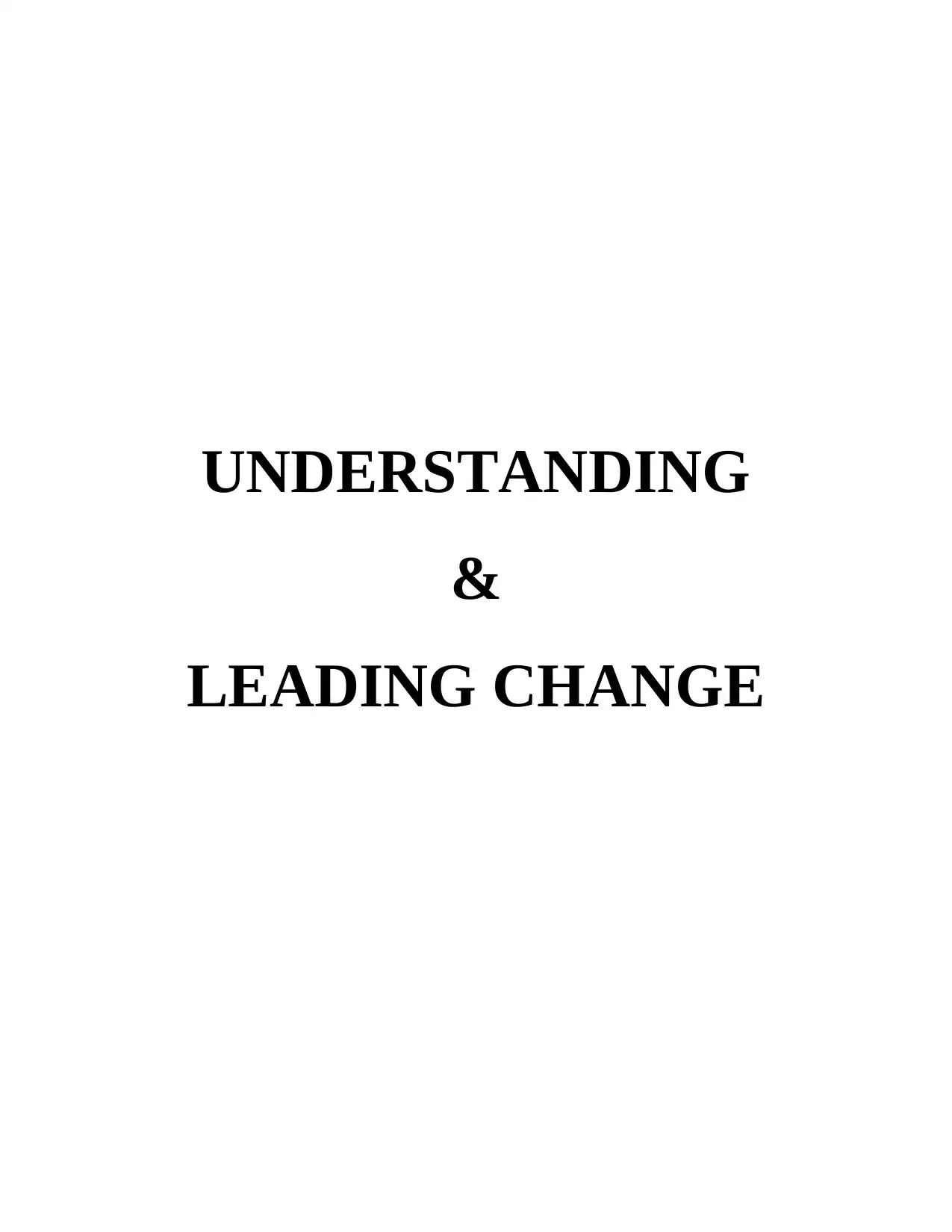
UNDERSTANDING
&
LEADING CHANGE
&
LEADING CHANGE
Paraphrase This Document
Need a fresh take? Get an instant paraphrase of this document with our AI Paraphraser
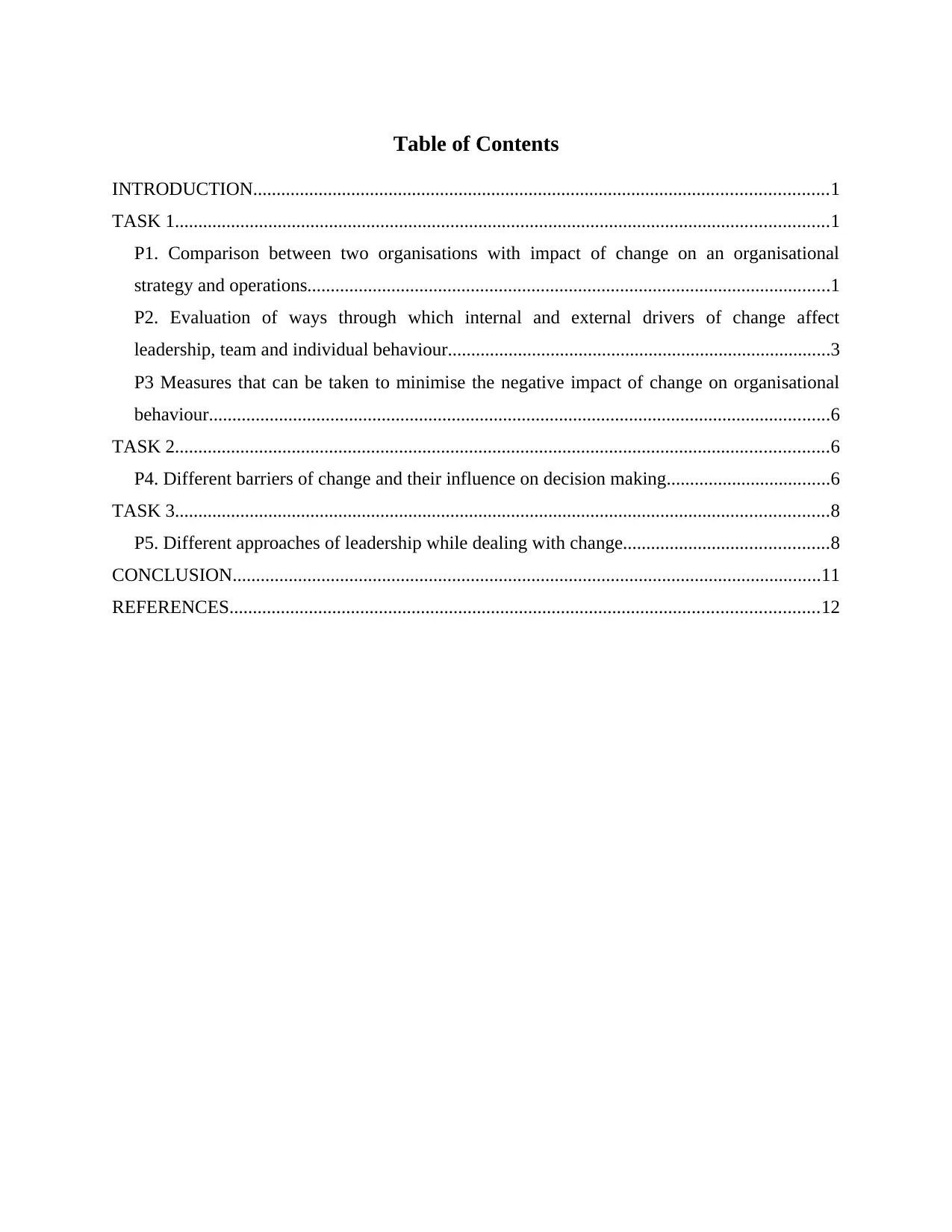
Table of Contents
INTRODUCTION...........................................................................................................................1
TASK 1............................................................................................................................................1
P1. Comparison between two organisations with impact of change on an organisational
strategy and operations................................................................................................................1
P2. Evaluation of ways through which internal and external drivers of change affect
leadership, team and individual behaviour..................................................................................3
P3 Measures that can be taken to minimise the negative impact of change on organisational
behaviour.....................................................................................................................................6
TASK 2............................................................................................................................................6
P4. Different barriers of change and their influence on decision making...................................6
TASK 3............................................................................................................................................8
P5. Different approaches of leadership while dealing with change............................................8
CONCLUSION..............................................................................................................................11
REFERENCES..............................................................................................................................12
INTRODUCTION...........................................................................................................................1
TASK 1............................................................................................................................................1
P1. Comparison between two organisations with impact of change on an organisational
strategy and operations................................................................................................................1
P2. Evaluation of ways through which internal and external drivers of change affect
leadership, team and individual behaviour..................................................................................3
P3 Measures that can be taken to minimise the negative impact of change on organisational
behaviour.....................................................................................................................................6
TASK 2............................................................................................................................................6
P4. Different barriers of change and their influence on decision making...................................6
TASK 3............................................................................................................................................8
P5. Different approaches of leadership while dealing with change............................................8
CONCLUSION..............................................................................................................................11
REFERENCES..............................................................................................................................12

⊘ This is a preview!⊘
Do you want full access?
Subscribe today to unlock all pages.

Trusted by 1+ million students worldwide
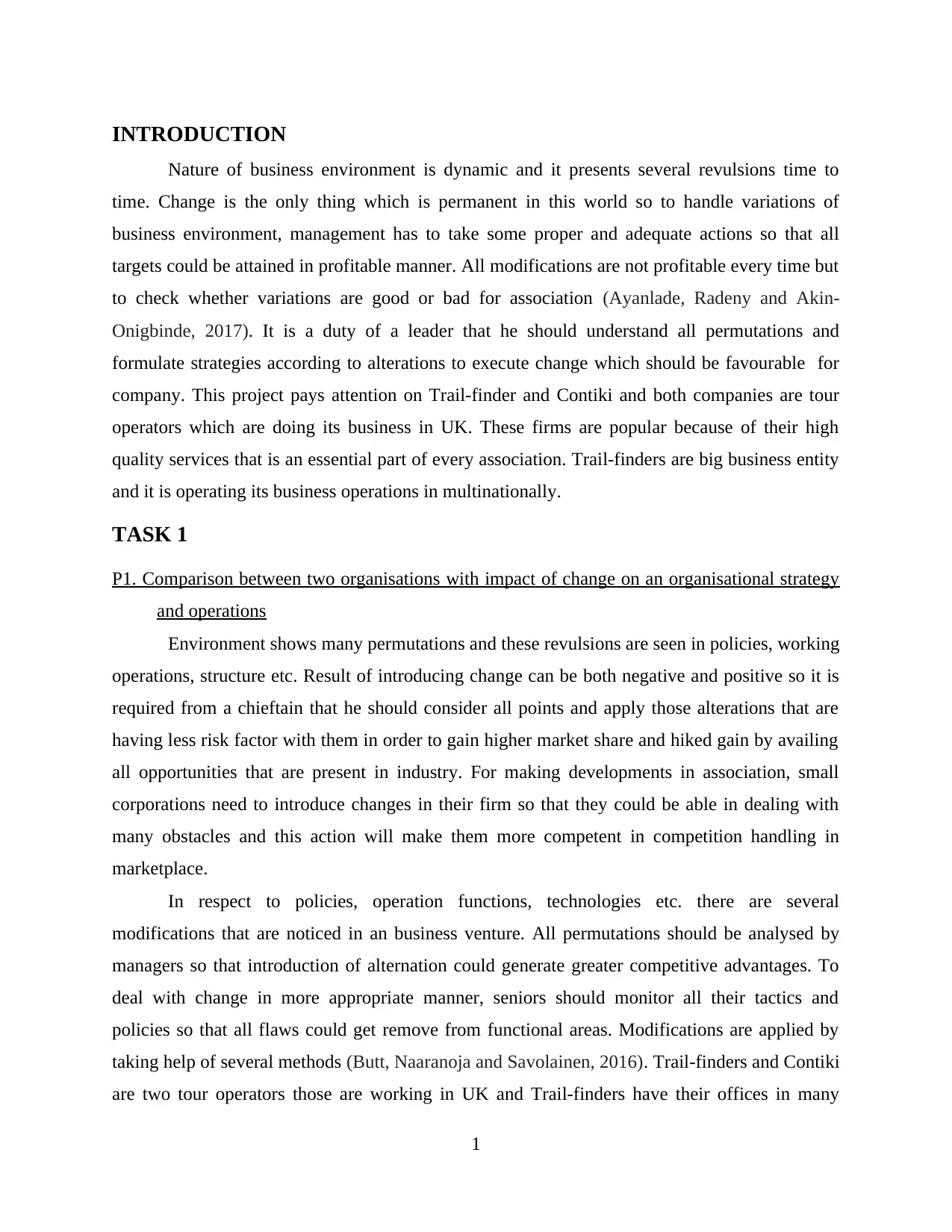
INTRODUCTION
Nature of business environment is dynamic and it presents several revulsions time to
time. Change is the only thing which is permanent in this world so to handle variations of
business environment, management has to take some proper and adequate actions so that all
targets could be attained in profitable manner. All modifications are not profitable every time but
to check whether variations are good or bad for association (Ayanlade, Radeny and Akin-
Onigbinde, 2017). It is a duty of a leader that he should understand all permutations and
formulate strategies according to alterations to execute change which should be favourable for
company. This project pays attention on Trail-finder and Contiki and both companies are tour
operators which are doing its business in UK. These firms are popular because of their high
quality services that is an essential part of every association. Trail-finders are big business entity
and it is operating its business operations in multinationally.
TASK 1
P1. Comparison between two organisations with impact of change on an organisational strategy
and operations
Environment shows many permutations and these revulsions are seen in policies, working
operations, structure etc. Result of introducing change can be both negative and positive so it is
required from a chieftain that he should consider all points and apply those alterations that are
having less risk factor with them in order to gain higher market share and hiked gain by availing
all opportunities that are present in industry. For making developments in association, small
corporations need to introduce changes in their firm so that they could be able in dealing with
many obstacles and this action will make them more competent in competition handling in
marketplace.
In respect to policies, operation functions, technologies etc. there are several
modifications that are noticed in an business venture. All permutations should be analysed by
managers so that introduction of alternation could generate greater competitive advantages. To
deal with change in more appropriate manner, seniors should monitor all their tactics and
policies so that all flaws could get remove from functional areas. Modifications are applied by
taking help of several methods (Butt, Naaranoja and Savolainen, 2016). Trail-finders and Contiki
are two tour operators those are working in UK and Trail-finders have their offices in many
1
Nature of business environment is dynamic and it presents several revulsions time to
time. Change is the only thing which is permanent in this world so to handle variations of
business environment, management has to take some proper and adequate actions so that all
targets could be attained in profitable manner. All modifications are not profitable every time but
to check whether variations are good or bad for association (Ayanlade, Radeny and Akin-
Onigbinde, 2017). It is a duty of a leader that he should understand all permutations and
formulate strategies according to alterations to execute change which should be favourable for
company. This project pays attention on Trail-finder and Contiki and both companies are tour
operators which are doing its business in UK. These firms are popular because of their high
quality services that is an essential part of every association. Trail-finders are big business entity
and it is operating its business operations in multinationally.
TASK 1
P1. Comparison between two organisations with impact of change on an organisational strategy
and operations
Environment shows many permutations and these revulsions are seen in policies, working
operations, structure etc. Result of introducing change can be both negative and positive so it is
required from a chieftain that he should consider all points and apply those alterations that are
having less risk factor with them in order to gain higher market share and hiked gain by availing
all opportunities that are present in industry. For making developments in association, small
corporations need to introduce changes in their firm so that they could be able in dealing with
many obstacles and this action will make them more competent in competition handling in
marketplace.
In respect to policies, operation functions, technologies etc. there are several
modifications that are noticed in an business venture. All permutations should be analysed by
managers so that introduction of alternation could generate greater competitive advantages. To
deal with change in more appropriate manner, seniors should monitor all their tactics and
policies so that all flaws could get remove from functional areas. Modifications are applied by
taking help of several methods (Butt, Naaranoja and Savolainen, 2016). Trail-finders and Contiki
are two tour operators those are working in UK and Trail-finders have their offices in many
1
Paraphrase This Document
Need a fresh take? Get an instant paraphrase of this document with our AI Paraphraser
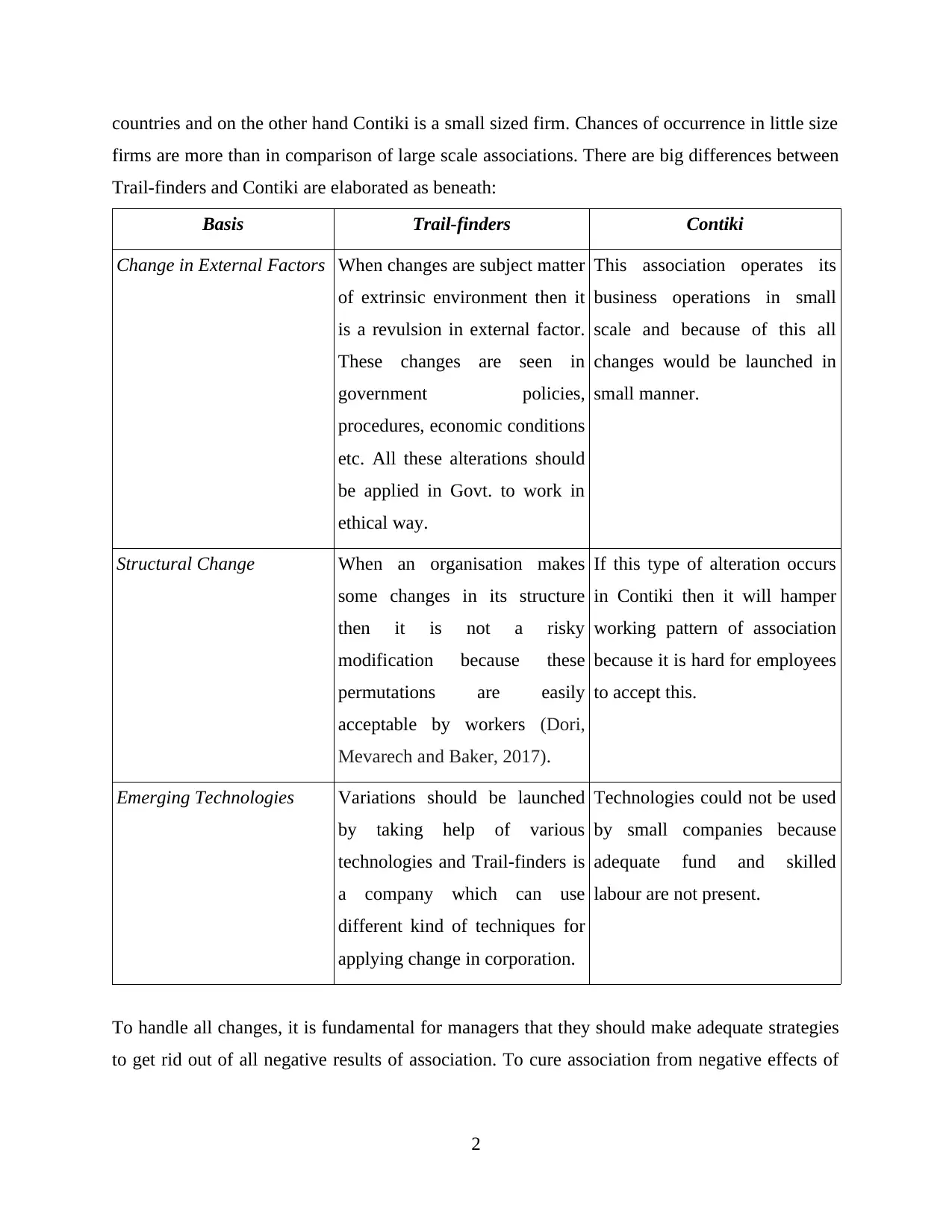
countries and on the other hand Contiki is a small sized firm. Chances of occurrence in little size
firms are more than in comparison of large scale associations. There are big differences between
Trail-finders and Contiki are elaborated as beneath:
Basis Trail-finders Contiki
Change in External Factors When changes are subject matter
of extrinsic environment then it
is a revulsion in external factor.
These changes are seen in
government policies,
procedures, economic conditions
etc. All these alterations should
be applied in Govt. to work in
ethical way.
This association operates its
business operations in small
scale and because of this all
changes would be launched in
small manner.
Structural Change When an organisation makes
some changes in its structure
then it is not a risky
modification because these
permutations are easily
acceptable by workers (Dori,
Mevarech and Baker, 2017).
If this type of alteration occurs
in Contiki then it will hamper
working pattern of association
because it is hard for employees
to accept this.
Emerging Technologies Variations should be launched
by taking help of various
technologies and Trail-finders is
a company which can use
different kind of techniques for
applying change in corporation.
Technologies could not be used
by small companies because
adequate fund and skilled
labour are not present.
To handle all changes, it is fundamental for managers that they should make adequate strategies
to get rid out of all negative results of association. To cure association from negative effects of
2
firms are more than in comparison of large scale associations. There are big differences between
Trail-finders and Contiki are elaborated as beneath:
Basis Trail-finders Contiki
Change in External Factors When changes are subject matter
of extrinsic environment then it
is a revulsion in external factor.
These changes are seen in
government policies,
procedures, economic conditions
etc. All these alterations should
be applied in Govt. to work in
ethical way.
This association operates its
business operations in small
scale and because of this all
changes would be launched in
small manner.
Structural Change When an organisation makes
some changes in its structure
then it is not a risky
modification because these
permutations are easily
acceptable by workers (Dori,
Mevarech and Baker, 2017).
If this type of alteration occurs
in Contiki then it will hamper
working pattern of association
because it is hard for employees
to accept this.
Emerging Technologies Variations should be launched
by taking help of various
technologies and Trail-finders is
a company which can use
different kind of techniques for
applying change in corporation.
Technologies could not be used
by small companies because
adequate fund and skilled
labour are not present.
To handle all changes, it is fundamental for managers that they should make adequate strategies
to get rid out of all negative results of association. To cure association from negative effects of
2
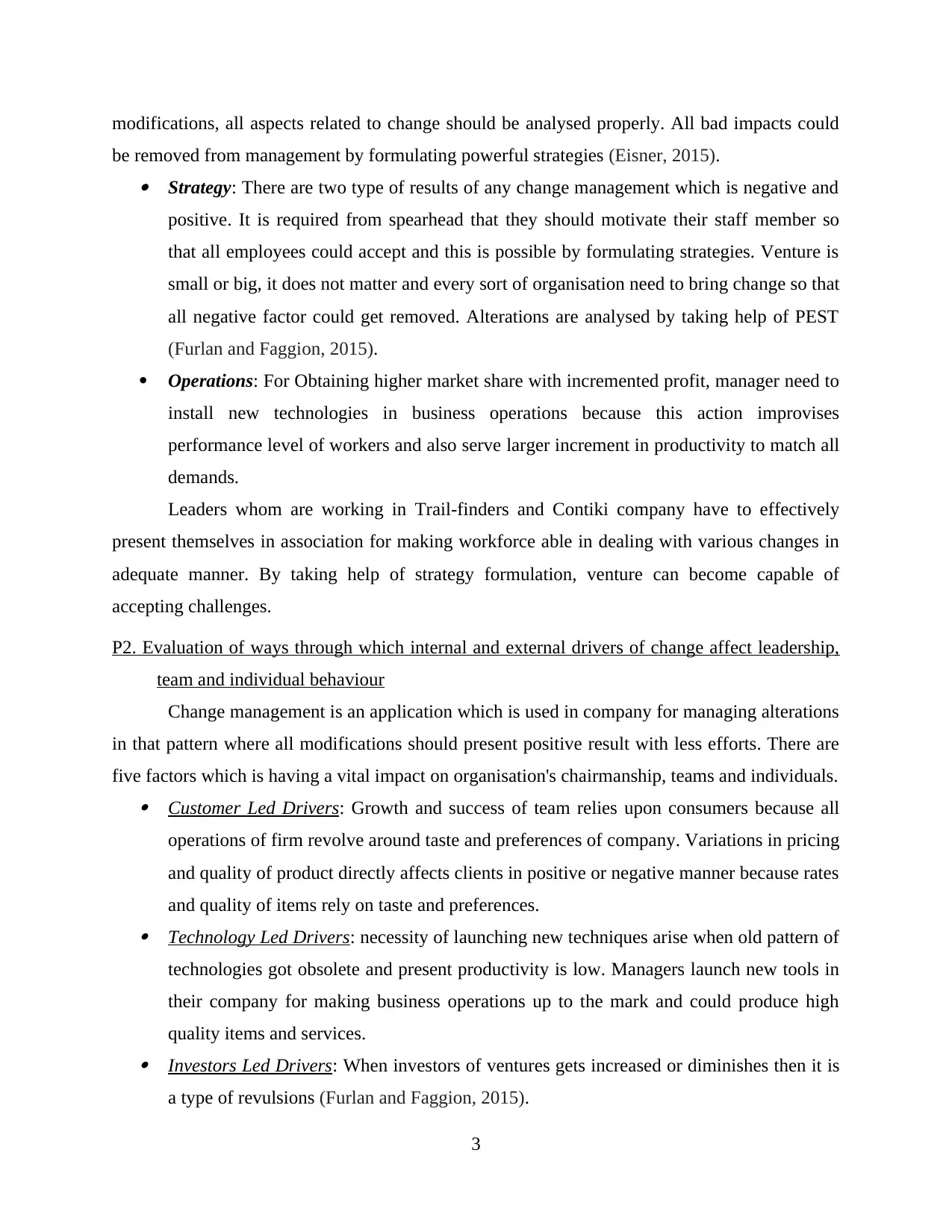
modifications, all aspects related to change should be analysed properly. All bad impacts could
be removed from management by formulating powerful strategies (Eisner, 2015). Strategy: There are two type of results of any change management which is negative and
positive. It is required from spearhead that they should motivate their staff member so
that all employees could accept and this is possible by formulating strategies. Venture is
small or big, it does not matter and every sort of organisation need to bring change so that
all negative factor could get removed. Alterations are analysed by taking help of PEST
(Furlan and Faggion, 2015).
Operations: For Obtaining higher market share with incremented profit, manager need to
install new technologies in business operations because this action improvises
performance level of workers and also serve larger increment in productivity to match all
demands.
Leaders whom are working in Trail-finders and Contiki company have to effectively
present themselves in association for making workforce able in dealing with various changes in
adequate manner. By taking help of strategy formulation, venture can become capable of
accepting challenges.
P2. Evaluation of ways through which internal and external drivers of change affect leadership,
team and individual behaviour
Change management is an application which is used in company for managing alterations
in that pattern where all modifications should present positive result with less efforts. There are
five factors which is having a vital impact on organisation's chairmanship, teams and individuals. Customer Led Drivers: Growth and success of team relies upon consumers because all
operations of firm revolve around taste and preferences of company. Variations in pricing
and quality of product directly affects clients in positive or negative manner because rates
and quality of items rely on taste and preferences. Technology Led Drivers: necessity of launching new techniques arise when old pattern of
technologies got obsolete and present productivity is low. Managers launch new tools in
their company for making business operations up to the mark and could produce high
quality items and services. Investors Led Drivers: When investors of ventures gets increased or diminishes then it is
a type of revulsions (Furlan and Faggion, 2015).
3
be removed from management by formulating powerful strategies (Eisner, 2015). Strategy: There are two type of results of any change management which is negative and
positive. It is required from spearhead that they should motivate their staff member so
that all employees could accept and this is possible by formulating strategies. Venture is
small or big, it does not matter and every sort of organisation need to bring change so that
all negative factor could get removed. Alterations are analysed by taking help of PEST
(Furlan and Faggion, 2015).
Operations: For Obtaining higher market share with incremented profit, manager need to
install new technologies in business operations because this action improvises
performance level of workers and also serve larger increment in productivity to match all
demands.
Leaders whom are working in Trail-finders and Contiki company have to effectively
present themselves in association for making workforce able in dealing with various changes in
adequate manner. By taking help of strategy formulation, venture can become capable of
accepting challenges.
P2. Evaluation of ways through which internal and external drivers of change affect leadership,
team and individual behaviour
Change management is an application which is used in company for managing alterations
in that pattern where all modifications should present positive result with less efforts. There are
five factors which is having a vital impact on organisation's chairmanship, teams and individuals. Customer Led Drivers: Growth and success of team relies upon consumers because all
operations of firm revolve around taste and preferences of company. Variations in pricing
and quality of product directly affects clients in positive or negative manner because rates
and quality of items rely on taste and preferences. Technology Led Drivers: necessity of launching new techniques arise when old pattern of
technologies got obsolete and present productivity is low. Managers launch new tools in
their company for making business operations up to the mark and could produce high
quality items and services. Investors Led Drivers: When investors of ventures gets increased or diminishes then it is
a type of revulsions (Furlan and Faggion, 2015).
3
⊘ This is a preview!⊘
Do you want full access?
Subscribe today to unlock all pages.

Trusted by 1+ million students worldwide
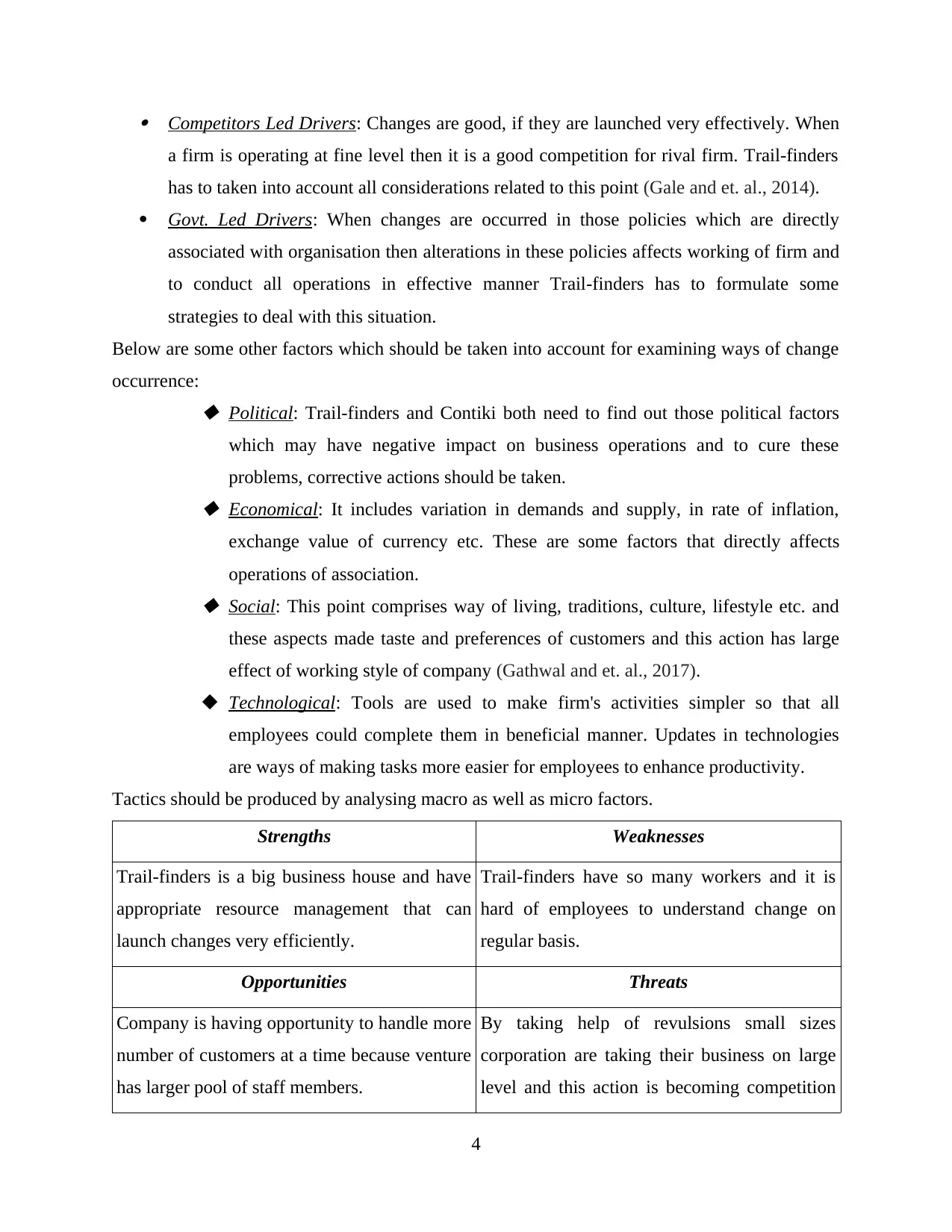
Competitors Led Drivers: Changes are good, if they are launched very effectively. When
a firm is operating at fine level then it is a good competition for rival firm. Trail-finders
has to taken into account all considerations related to this point (Gale and et. al., 2014).
Govt. Led Drivers: When changes are occurred in those policies which are directly
associated with organisation then alterations in these policies affects working of firm and
to conduct all operations in effective manner Trail-finders has to formulate some
strategies to deal with this situation.
Below are some other factors which should be taken into account for examining ways of change
occurrence:
Political: Trail-finders and Contiki both need to find out those political factors
which may have negative impact on business operations and to cure these
problems, corrective actions should be taken.
Economical: It includes variation in demands and supply, in rate of inflation,
exchange value of currency etc. These are some factors that directly affects
operations of association.
Social: This point comprises way of living, traditions, culture, lifestyle etc. and
these aspects made taste and preferences of customers and this action has large
effect of working style of company (Gathwal and et. al., 2017).
Technological: Tools are used to make firm's activities simpler so that all
employees could complete them in beneficial manner. Updates in technologies
are ways of making tasks more easier for employees to enhance productivity.
Tactics should be produced by analysing macro as well as micro factors.
Strengths Weaknesses
Trail-finders is a big business house and have
appropriate resource management that can
launch changes very efficiently.
Trail-finders have so many workers and it is
hard of employees to understand change on
regular basis.
Opportunities Threats
Company is having opportunity to handle more
number of customers at a time because venture
has larger pool of staff members.
By taking help of revulsions small sizes
corporation are taking their business on large
level and this action is becoming competition
4
a firm is operating at fine level then it is a good competition for rival firm. Trail-finders
has to taken into account all considerations related to this point (Gale and et. al., 2014).
Govt. Led Drivers: When changes are occurred in those policies which are directly
associated with organisation then alterations in these policies affects working of firm and
to conduct all operations in effective manner Trail-finders has to formulate some
strategies to deal with this situation.
Below are some other factors which should be taken into account for examining ways of change
occurrence:
Political: Trail-finders and Contiki both need to find out those political factors
which may have negative impact on business operations and to cure these
problems, corrective actions should be taken.
Economical: It includes variation in demands and supply, in rate of inflation,
exchange value of currency etc. These are some factors that directly affects
operations of association.
Social: This point comprises way of living, traditions, culture, lifestyle etc. and
these aspects made taste and preferences of customers and this action has large
effect of working style of company (Gathwal and et. al., 2017).
Technological: Tools are used to make firm's activities simpler so that all
employees could complete them in beneficial manner. Updates in technologies
are ways of making tasks more easier for employees to enhance productivity.
Tactics should be produced by analysing macro as well as micro factors.
Strengths Weaknesses
Trail-finders is a big business house and have
appropriate resource management that can
launch changes very efficiently.
Trail-finders have so many workers and it is
hard of employees to understand change on
regular basis.
Opportunities Threats
Company is having opportunity to handle more
number of customers at a time because venture
has larger pool of staff members.
By taking help of revulsions small sizes
corporation are taking their business on large
level and this action is becoming competition
4
Paraphrase This Document
Need a fresh take? Get an instant paraphrase of this document with our AI Paraphraser
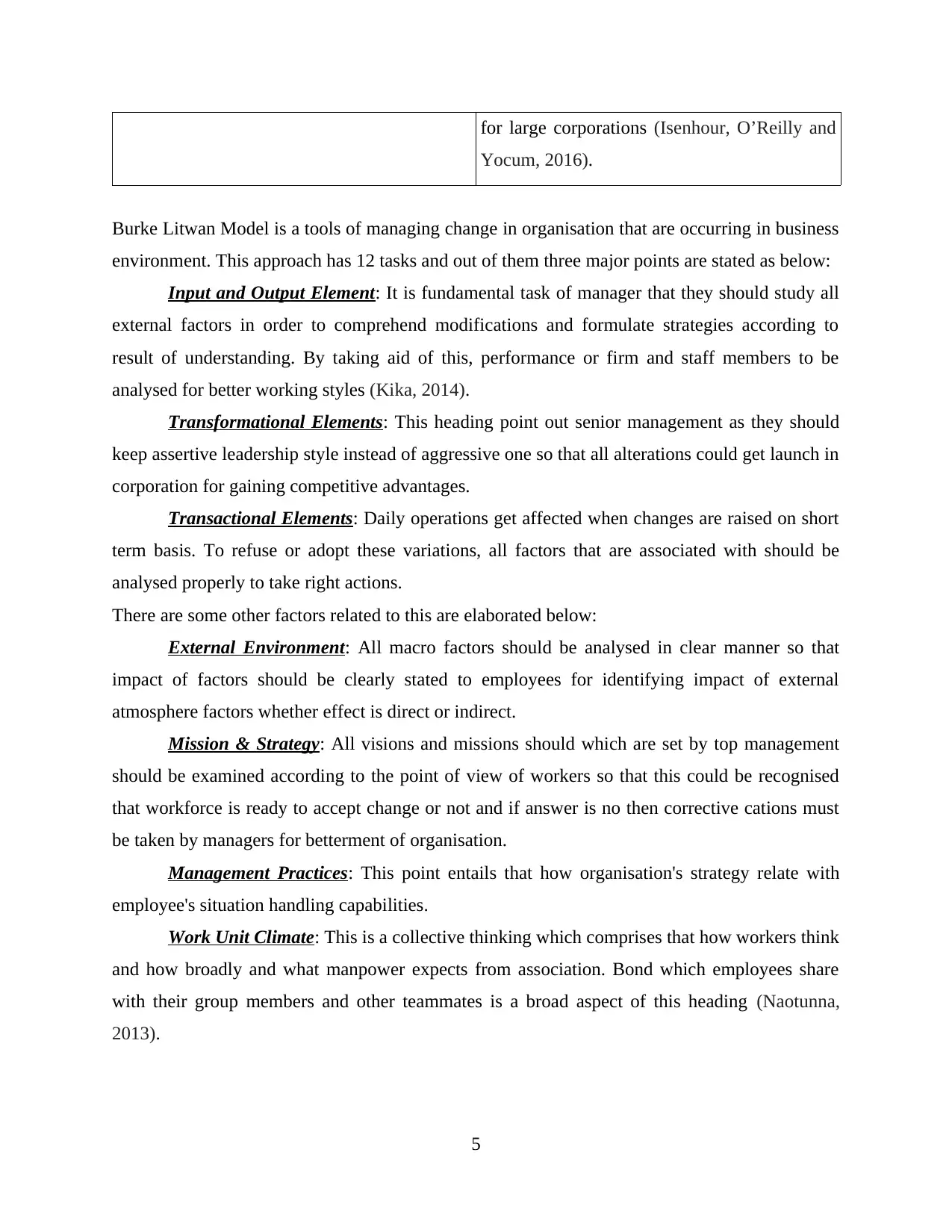
for large corporations (Isenhour, O’Reilly and
Yocum, 2016).
Burke Litwan Model is a tools of managing change in organisation that are occurring in business
environment. This approach has 12 tasks and out of them three major points are stated as below:
Input and Output Element: It is fundamental task of manager that they should study all
external factors in order to comprehend modifications and formulate strategies according to
result of understanding. By taking aid of this, performance or firm and staff members to be
analysed for better working styles (Kika, 2014).
Transformational Elements: This heading point out senior management as they should
keep assertive leadership style instead of aggressive one so that all alterations could get launch in
corporation for gaining competitive advantages.
Transactional Elements: Daily operations get affected when changes are raised on short
term basis. To refuse or adopt these variations, all factors that are associated with should be
analysed properly to take right actions.
There are some other factors related to this are elaborated below:
External Environment: All macro factors should be analysed in clear manner so that
impact of factors should be clearly stated to employees for identifying impact of external
atmosphere factors whether effect is direct or indirect.
Mission & Strategy: All visions and missions should which are set by top management
should be examined according to the point of view of workers so that this could be recognised
that workforce is ready to accept change or not and if answer is no then corrective cations must
be taken by managers for betterment of organisation.
Management Practices: This point entails that how organisation's strategy relate with
employee's situation handling capabilities.
Work Unit Climate: This is a collective thinking which comprises that how workers think
and how broadly and what manpower expects from association. Bond which employees share
with their group members and other teammates is a broad aspect of this heading (Naotunna,
2013).
5
Yocum, 2016).
Burke Litwan Model is a tools of managing change in organisation that are occurring in business
environment. This approach has 12 tasks and out of them three major points are stated as below:
Input and Output Element: It is fundamental task of manager that they should study all
external factors in order to comprehend modifications and formulate strategies according to
result of understanding. By taking aid of this, performance or firm and staff members to be
analysed for better working styles (Kika, 2014).
Transformational Elements: This heading point out senior management as they should
keep assertive leadership style instead of aggressive one so that all alterations could get launch in
corporation for gaining competitive advantages.
Transactional Elements: Daily operations get affected when changes are raised on short
term basis. To refuse or adopt these variations, all factors that are associated with should be
analysed properly to take right actions.
There are some other factors related to this are elaborated below:
External Environment: All macro factors should be analysed in clear manner so that
impact of factors should be clearly stated to employees for identifying impact of external
atmosphere factors whether effect is direct or indirect.
Mission & Strategy: All visions and missions should which are set by top management
should be examined according to the point of view of workers so that this could be recognised
that workforce is ready to accept change or not and if answer is no then corrective cations must
be taken by managers for betterment of organisation.
Management Practices: This point entails that how organisation's strategy relate with
employee's situation handling capabilities.
Work Unit Climate: This is a collective thinking which comprises that how workers think
and how broadly and what manpower expects from association. Bond which employees share
with their group members and other teammates is a broad aspect of this heading (Naotunna,
2013).
5
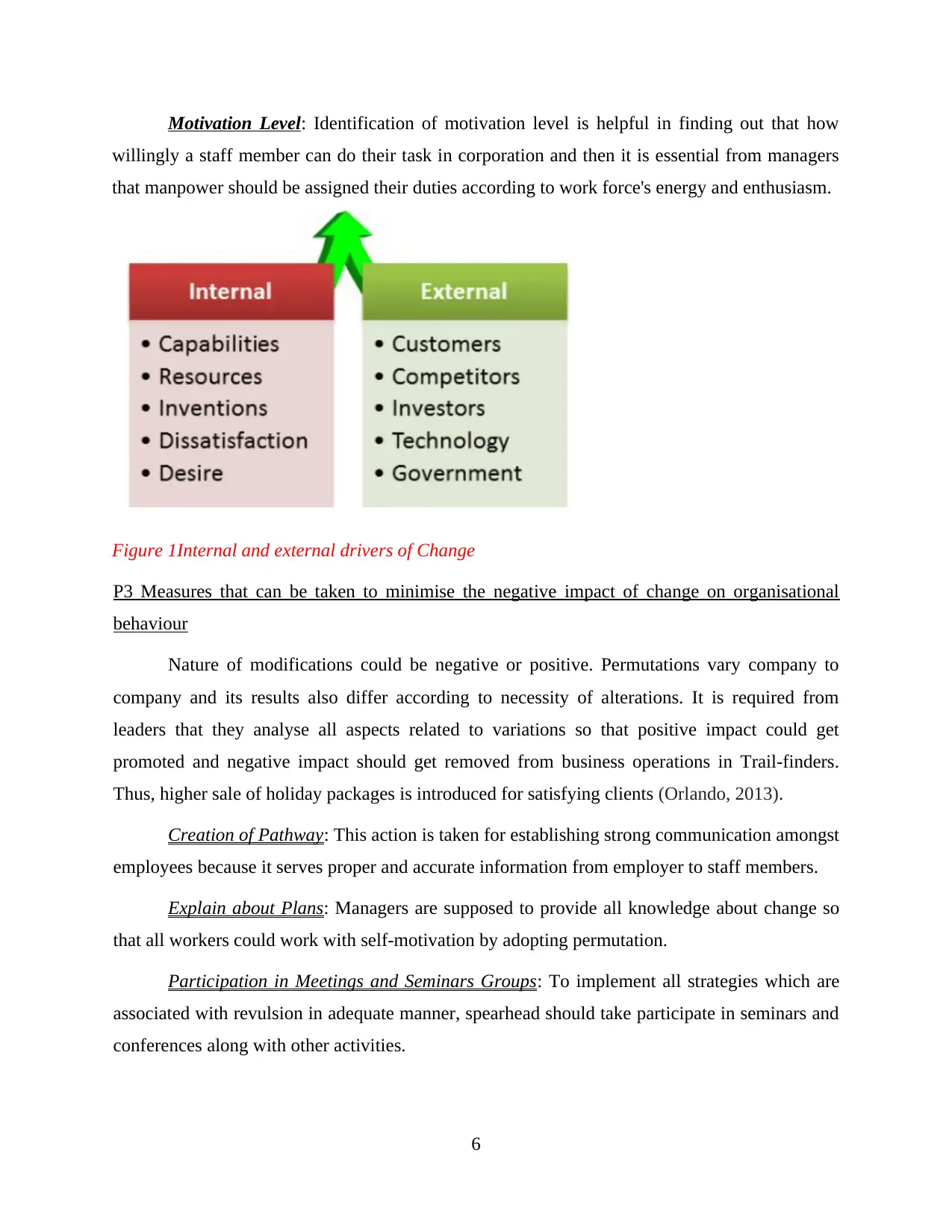
Motivation Level: Identification of motivation level is helpful in finding out that how
willingly a staff member can do their task in corporation and then it is essential from managers
that manpower should be assigned their duties according to work force's energy and enthusiasm.
Figure 1Internal and external drivers of Change
P3 Measures that can be taken to minimise the negative impact of change on organisational
behaviour
Nature of modifications could be negative or positive. Permutations vary company to
company and its results also differ according to necessity of alterations. It is required from
leaders that they analyse all aspects related to variations so that positive impact could get
promoted and negative impact should get removed from business operations in Trail-finders.
Thus, higher sale of holiday packages is introduced for satisfying clients (Orlando, 2013).
Creation of Pathway: This action is taken for establishing strong communication amongst
employees because it serves proper and accurate information from employer to staff members.
Explain about Plans: Managers are supposed to provide all knowledge about change so
that all workers could work with self-motivation by adopting permutation.
Participation in Meetings and Seminars Groups: To implement all strategies which are
associated with revulsion in adequate manner, spearhead should take participate in seminars and
conferences along with other activities.
6
willingly a staff member can do their task in corporation and then it is essential from managers
that manpower should be assigned their duties according to work force's energy and enthusiasm.
Figure 1Internal and external drivers of Change
P3 Measures that can be taken to minimise the negative impact of change on organisational
behaviour
Nature of modifications could be negative or positive. Permutations vary company to
company and its results also differ according to necessity of alterations. It is required from
leaders that they analyse all aspects related to variations so that positive impact could get
promoted and negative impact should get removed from business operations in Trail-finders.
Thus, higher sale of holiday packages is introduced for satisfying clients (Orlando, 2013).
Creation of Pathway: This action is taken for establishing strong communication amongst
employees because it serves proper and accurate information from employer to staff members.
Explain about Plans: Managers are supposed to provide all knowledge about change so
that all workers could work with self-motivation by adopting permutation.
Participation in Meetings and Seminars Groups: To implement all strategies which are
associated with revulsion in adequate manner, spearhead should take participate in seminars and
conferences along with other activities.
6
⊘ This is a preview!⊘
Do you want full access?
Subscribe today to unlock all pages.

Trusted by 1+ million students worldwide
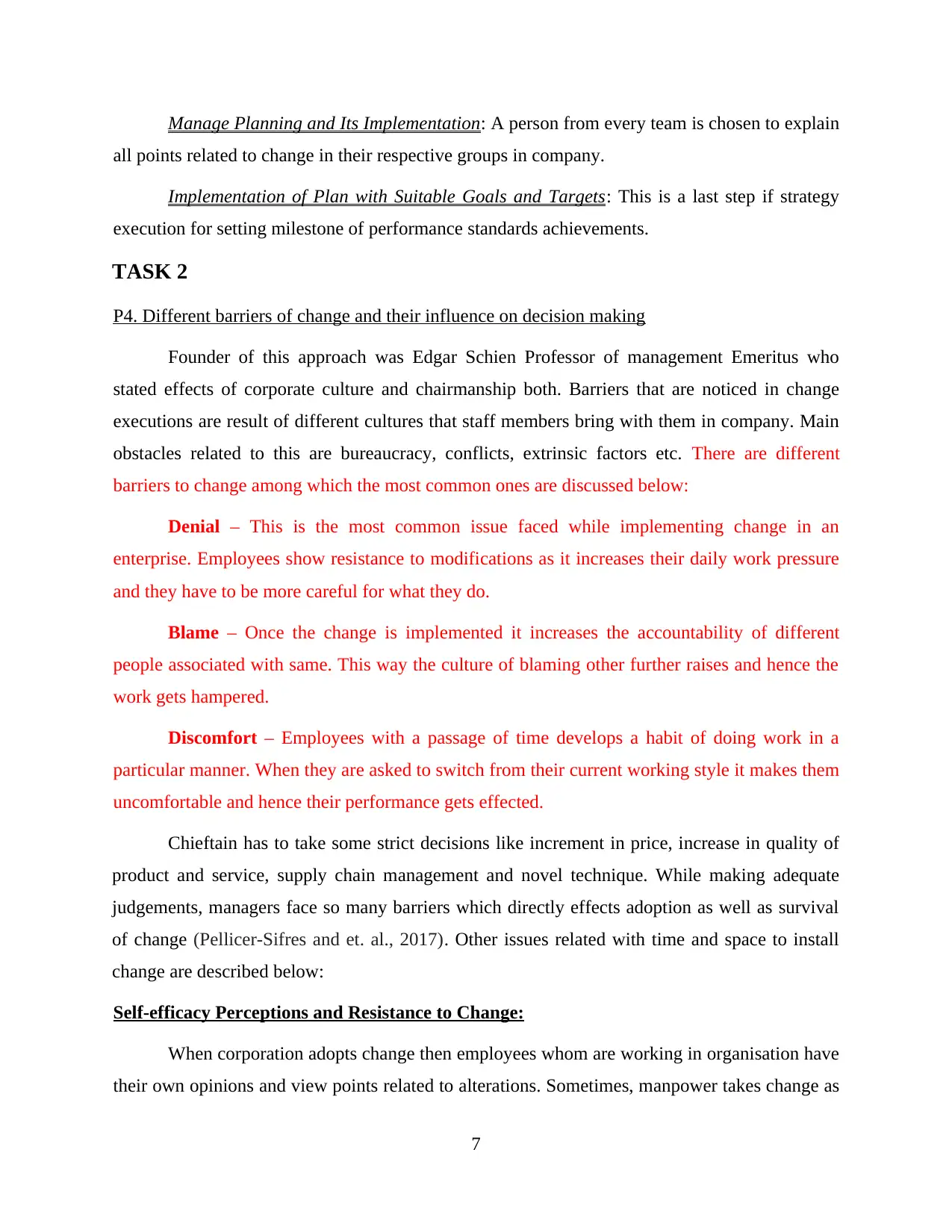
Manage Planning and Its Implementation: A person from every team is chosen to explain
all points related to change in their respective groups in company.
Implementation of Plan with Suitable Goals and Targets: This is a last step if strategy
execution for setting milestone of performance standards achievements.
TASK 2
P4. Different barriers of change and their influence on decision making
Founder of this approach was Edgar Schien Professor of management Emeritus who
stated effects of corporate culture and chairmanship both. Barriers that are noticed in change
executions are result of different cultures that staff members bring with them in company. Main
obstacles related to this are bureaucracy, conflicts, extrinsic factors etc. There are different
barriers to change among which the most common ones are discussed below:
Denial – This is the most common issue faced while implementing change in an
enterprise. Employees show resistance to modifications as it increases their daily work pressure
and they have to be more careful for what they do.
Blame – Once the change is implemented it increases the accountability of different
people associated with same. This way the culture of blaming other further raises and hence the
work gets hampered.
Discomfort – Employees with a passage of time develops a habit of doing work in a
particular manner. When they are asked to switch from their current working style it makes them
uncomfortable and hence their performance gets effected.
Chieftain has to take some strict decisions like increment in price, increase in quality of
product and service, supply chain management and novel technique. While making adequate
judgements, managers face so many barriers which directly effects adoption as well as survival
of change (Pellicer-Sifres and et. al., 2017). Other issues related with time and space to install
change are described below:
Self-efficacy Perceptions and Resistance to Change:
When corporation adopts change then employees whom are working in organisation have
their own opinions and view points related to alterations. Sometimes, manpower takes change as
7
all points related to change in their respective groups in company.
Implementation of Plan with Suitable Goals and Targets: This is a last step if strategy
execution for setting milestone of performance standards achievements.
TASK 2
P4. Different barriers of change and their influence on decision making
Founder of this approach was Edgar Schien Professor of management Emeritus who
stated effects of corporate culture and chairmanship both. Barriers that are noticed in change
executions are result of different cultures that staff members bring with them in company. Main
obstacles related to this are bureaucracy, conflicts, extrinsic factors etc. There are different
barriers to change among which the most common ones are discussed below:
Denial – This is the most common issue faced while implementing change in an
enterprise. Employees show resistance to modifications as it increases their daily work pressure
and they have to be more careful for what they do.
Blame – Once the change is implemented it increases the accountability of different
people associated with same. This way the culture of blaming other further raises and hence the
work gets hampered.
Discomfort – Employees with a passage of time develops a habit of doing work in a
particular manner. When they are asked to switch from their current working style it makes them
uncomfortable and hence their performance gets effected.
Chieftain has to take some strict decisions like increment in price, increase in quality of
product and service, supply chain management and novel technique. While making adequate
judgements, managers face so many barriers which directly effects adoption as well as survival
of change (Pellicer-Sifres and et. al., 2017). Other issues related with time and space to install
change are described below:
Self-efficacy Perceptions and Resistance to Change:
When corporation adopts change then employees whom are working in organisation have
their own opinions and view points related to alterations. Sometimes, manpower takes change as
7
Paraphrase This Document
Need a fresh take? Get an instant paraphrase of this document with our AI Paraphraser
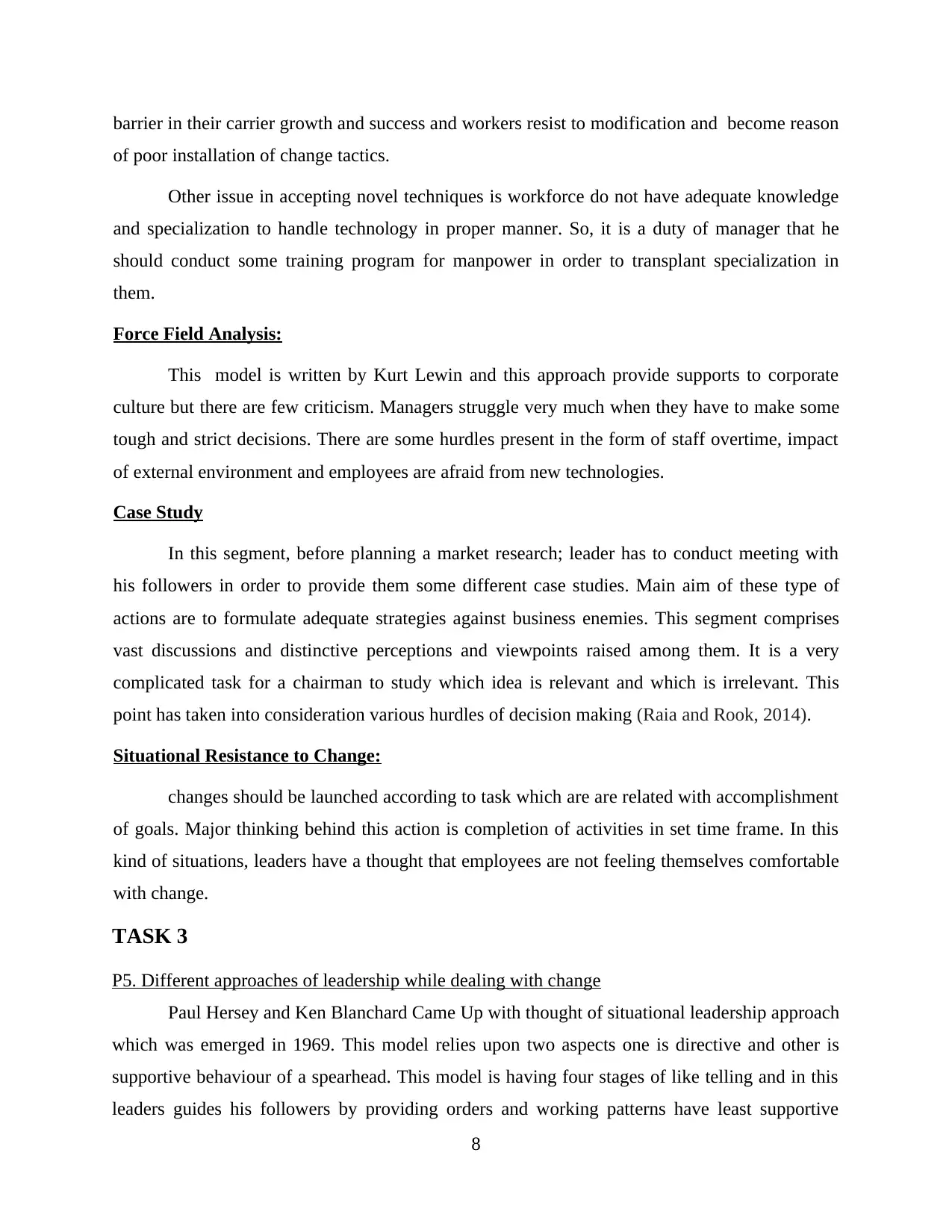
barrier in their carrier growth and success and workers resist to modification and become reason
of poor installation of change tactics.
Other issue in accepting novel techniques is workforce do not have adequate knowledge
and specialization to handle technology in proper manner. So, it is a duty of manager that he
should conduct some training program for manpower in order to transplant specialization in
them.
Force Field Analysis:
This model is written by Kurt Lewin and this approach provide supports to corporate
culture but there are few criticism. Managers struggle very much when they have to make some
tough and strict decisions. There are some hurdles present in the form of staff overtime, impact
of external environment and employees are afraid from new technologies.
Case Study
In this segment, before planning a market research; leader has to conduct meeting with
his followers in order to provide them some different case studies. Main aim of these type of
actions are to formulate adequate strategies against business enemies. This segment comprises
vast discussions and distinctive perceptions and viewpoints raised among them. It is a very
complicated task for a chairman to study which idea is relevant and which is irrelevant. This
point has taken into consideration various hurdles of decision making (Raia and Rook, 2014).
Situational Resistance to Change:
changes should be launched according to task which are are related with accomplishment
of goals. Major thinking behind this action is completion of activities in set time frame. In this
kind of situations, leaders have a thought that employees are not feeling themselves comfortable
with change.
TASK 3
P5. Different approaches of leadership while dealing with change
Paul Hersey and Ken Blanchard Came Up with thought of situational leadership approach
which was emerged in 1969. This model relies upon two aspects one is directive and other is
supportive behaviour of a spearhead. This model is having four stages of like telling and in this
leaders guides his followers by providing orders and working patterns have least supportive
8
of poor installation of change tactics.
Other issue in accepting novel techniques is workforce do not have adequate knowledge
and specialization to handle technology in proper manner. So, it is a duty of manager that he
should conduct some training program for manpower in order to transplant specialization in
them.
Force Field Analysis:
This model is written by Kurt Lewin and this approach provide supports to corporate
culture but there are few criticism. Managers struggle very much when they have to make some
tough and strict decisions. There are some hurdles present in the form of staff overtime, impact
of external environment and employees are afraid from new technologies.
Case Study
In this segment, before planning a market research; leader has to conduct meeting with
his followers in order to provide them some different case studies. Main aim of these type of
actions are to formulate adequate strategies against business enemies. This segment comprises
vast discussions and distinctive perceptions and viewpoints raised among them. It is a very
complicated task for a chairman to study which idea is relevant and which is irrelevant. This
point has taken into consideration various hurdles of decision making (Raia and Rook, 2014).
Situational Resistance to Change:
changes should be launched according to task which are are related with accomplishment
of goals. Major thinking behind this action is completion of activities in set time frame. In this
kind of situations, leaders have a thought that employees are not feeling themselves comfortable
with change.
TASK 3
P5. Different approaches of leadership while dealing with change
Paul Hersey and Ken Blanchard Came Up with thought of situational leadership approach
which was emerged in 1969. This model relies upon two aspects one is directive and other is
supportive behaviour of a spearhead. This model is having four stages of like telling and in this
leaders guides his followers by providing orders and working patterns have least supportive
8
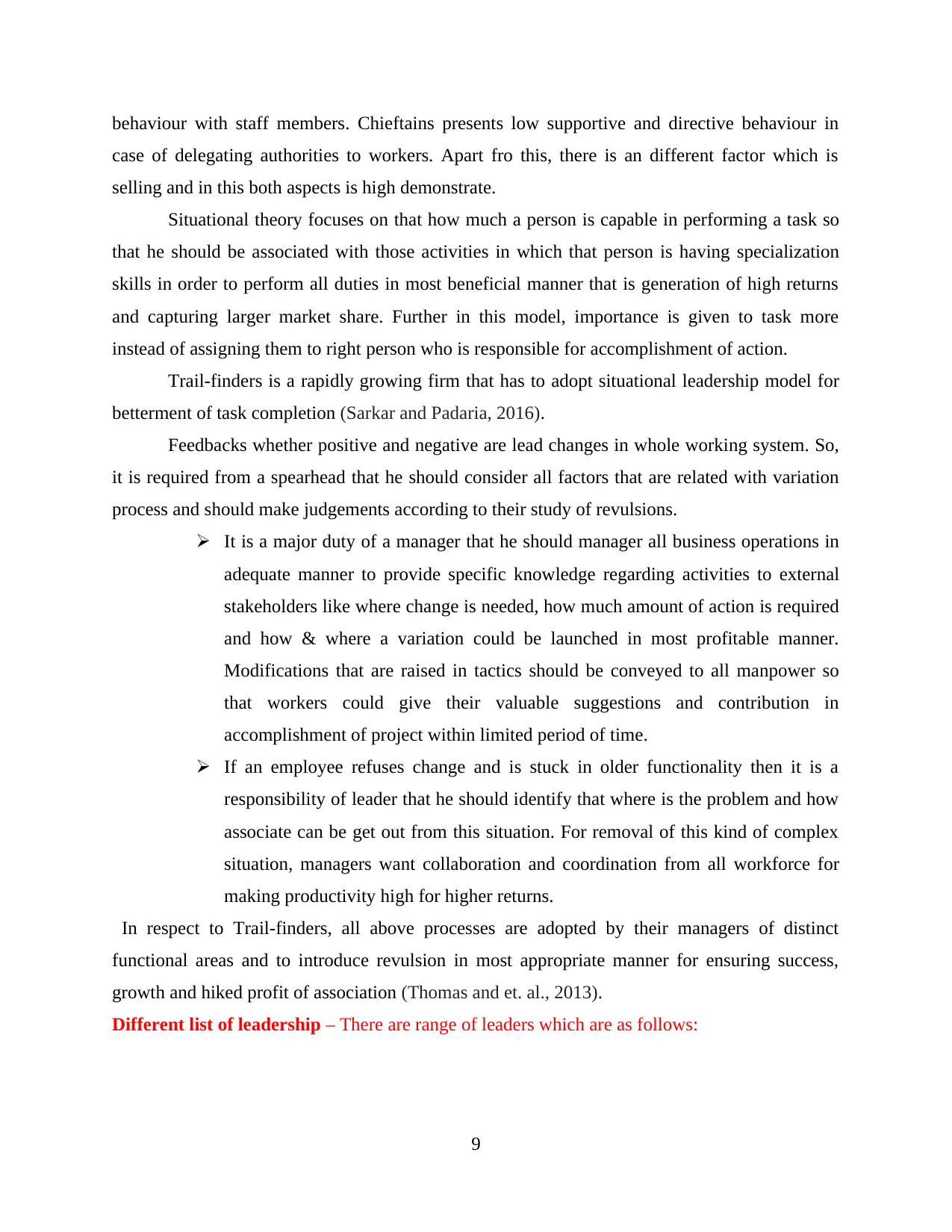
behaviour with staff members. Chieftains presents low supportive and directive behaviour in
case of delegating authorities to workers. Apart fro this, there is an different factor which is
selling and in this both aspects is high demonstrate.
Situational theory focuses on that how much a person is capable in performing a task so
that he should be associated with those activities in which that person is having specialization
skills in order to perform all duties in most beneficial manner that is generation of high returns
and capturing larger market share. Further in this model, importance is given to task more
instead of assigning them to right person who is responsible for accomplishment of action.
Trail-finders is a rapidly growing firm that has to adopt situational leadership model for
betterment of task completion (Sarkar and Padaria, 2016).
Feedbacks whether positive and negative are lead changes in whole working system. So,
it is required from a spearhead that he should consider all factors that are related with variation
process and should make judgements according to their study of revulsions.
It is a major duty of a manager that he should manager all business operations in
adequate manner to provide specific knowledge regarding activities to external
stakeholders like where change is needed, how much amount of action is required
and how & where a variation could be launched in most profitable manner.
Modifications that are raised in tactics should be conveyed to all manpower so
that workers could give their valuable suggestions and contribution in
accomplishment of project within limited period of time.
If an employee refuses change and is stuck in older functionality then it is a
responsibility of leader that he should identify that where is the problem and how
associate can be get out from this situation. For removal of this kind of complex
situation, managers want collaboration and coordination from all workforce for
making productivity high for higher returns.
In respect to Trail-finders, all above processes are adopted by their managers of distinct
functional areas and to introduce revulsion in most appropriate manner for ensuring success,
growth and hiked profit of association (Thomas and et. al., 2013).
Different list of leadership – There are range of leaders which are as follows:
9
case of delegating authorities to workers. Apart fro this, there is an different factor which is
selling and in this both aspects is high demonstrate.
Situational theory focuses on that how much a person is capable in performing a task so
that he should be associated with those activities in which that person is having specialization
skills in order to perform all duties in most beneficial manner that is generation of high returns
and capturing larger market share. Further in this model, importance is given to task more
instead of assigning them to right person who is responsible for accomplishment of action.
Trail-finders is a rapidly growing firm that has to adopt situational leadership model for
betterment of task completion (Sarkar and Padaria, 2016).
Feedbacks whether positive and negative are lead changes in whole working system. So,
it is required from a spearhead that he should consider all factors that are related with variation
process and should make judgements according to their study of revulsions.
It is a major duty of a manager that he should manager all business operations in
adequate manner to provide specific knowledge regarding activities to external
stakeholders like where change is needed, how much amount of action is required
and how & where a variation could be launched in most profitable manner.
Modifications that are raised in tactics should be conveyed to all manpower so
that workers could give their valuable suggestions and contribution in
accomplishment of project within limited period of time.
If an employee refuses change and is stuck in older functionality then it is a
responsibility of leader that he should identify that where is the problem and how
associate can be get out from this situation. For removal of this kind of complex
situation, managers want collaboration and coordination from all workforce for
making productivity high for higher returns.
In respect to Trail-finders, all above processes are adopted by their managers of distinct
functional areas and to introduce revulsion in most appropriate manner for ensuring success,
growth and hiked profit of association (Thomas and et. al., 2013).
Different list of leadership – There are range of leaders which are as follows:
9
⊘ This is a preview!⊘
Do you want full access?
Subscribe today to unlock all pages.

Trusted by 1+ million students worldwide
1 out of 17
Related Documents
Your All-in-One AI-Powered Toolkit for Academic Success.
+13062052269
info@desklib.com
Available 24*7 on WhatsApp / Email
![[object Object]](/_next/static/media/star-bottom.7253800d.svg)
Unlock your academic potential
Copyright © 2020–2025 A2Z Services. All Rights Reserved. Developed and managed by ZUCOL.





